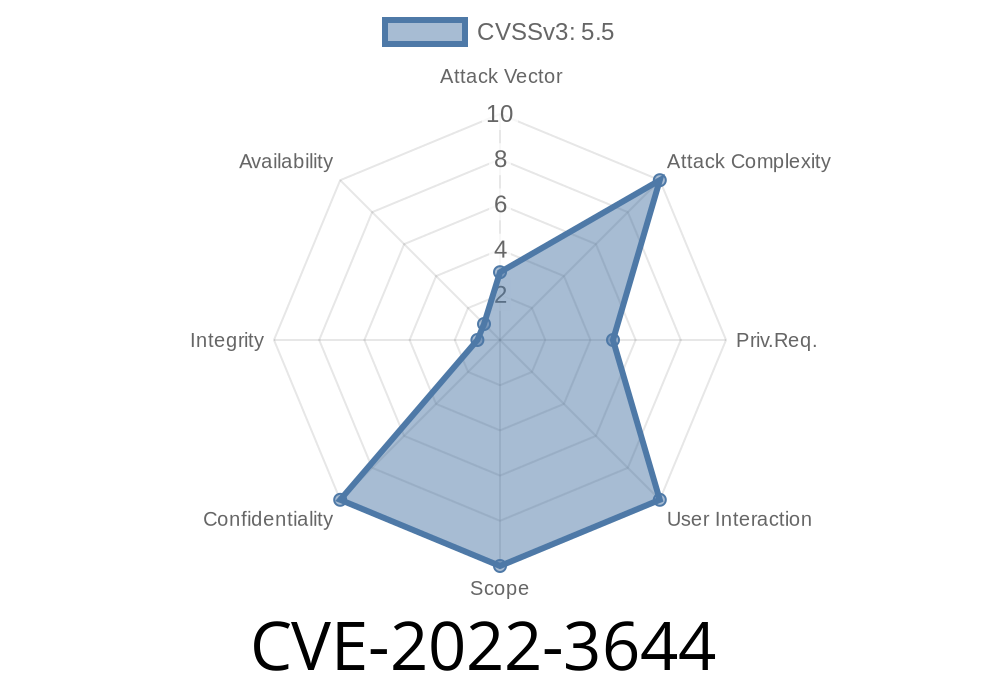In recent days, a critical security vulnerability has been identified in the collection remote for pulp_ansible, which serves as a Content Management System for managing and distributing software packages using the Ansible playbook. This vulnerability has been assigned the identifier CVE-2022-3644.
The issue stems from the fact that the pulp_ansible module stores tokens in plaintext, making them easily accessible to anyone with access to the server's filesystem. Furthermore, the API exposes the tokens in read/write mode rather than a more secure write-only mode. This flaw can lead to unauthorized access to sensitive tokens, which are crucial for authentication and authorization.
In this post, we will discuss the details of CVE-2022-3644, including a code snippet that showcases the vulnerability, links to original references, and exploit details. By the end of this post, you'll gain a thorough understanding of this critical security vulnerability and learn how to ensure the security of your tokens.
Code Snippet
The following code snippet demonstrates how the plaintext tokens are stored and exposed in the collection remote of pulp_ansible:
class CollectionRemote(models.Model):
...
token = models.TextField(
help_text=_("Token to authenticate with the server."),
)
...
As seen in the above code, the token field stores the authentication token as plaintext without any encryption or hashing. This directly exposes these sensitive tokens to potential attackers who gain access to the server's filesystem.
Links to Original References
1. CVE-2022-3644 - Official CVE entry with a description of the vulnerability.
2. Ansible Collection Remote Security Issue - GitHub issue in the pulp_ansible repository discussing the vulnerability.
3. Encrypting Fields in Pulp - Official Pulp documentation providing guidelines on using encrypted fields for sensitive data storage.
An attacker with access to the server can exploit this vulnerability in the following ways
1. Accessing the filesystem: If the attacker can access the server's filesystem where the pulp_ansible module stores the tokens, they can easily copy, modify or use the tokens for unauthorized activities or even delete the tokens, causing disruption in operations.
2. Token exposure through the API: Since the API exposes tokens in read/write mode, a potential attacker can directly read the tokens through the API. They can also modify the tokens, thereby gaining access to systems that rely on these tokens for authentication or authorization.
To protect your systems from CVE-2022-3644, we recommend the following steps
1. Encrypt tokens: Modify the CollectionRemote model to use the fields.EncryptedTextField field from Pulp, which encrypts sensitive data before storing it. The modified code snippet would look like this:
from pulpcore.plugin import fields
class CollectionRemote(models.Model):
...
token = fields.EncryptedTextField(
help_text=_("Token to authenticate with the server."),
)
...
2. Set the API endpoint for tokens as write-only: By marking the token field as write-only, you can prevent unauthorized users from reading the tokens through the API. This can be done by updating the serializers.py file to include the following line:
class CollectionRemoteSerializer(serializers.ModelSerializer):
...
token = serializers.CharField(write_only=True)
...
3. Maintain strong access controls: Ensure that only authorized users have access to the server's filesystem and API endpoints. Regularly audit and update access controls, and limit the number of privileged users.
Conclusion
It's essential to keep abreast of security vulnerabilities like CVE-2022-3644 and take action to mitigate their potential impact on your systems. By understanding and addressing such issues, you'll ensure that your Ansible playbook collections and other sensitive data remain secure and out of reach from malicious actors. Be sure to follow best practices for securely storing and managing sensitive tokens, and keep up-to-date with the latest security patches and updates for your software stack.
Timeline
Published on: 10/25/2022 18:15:00 UTC
Last modified on: 10/28/2022 19:01:00 UTC
